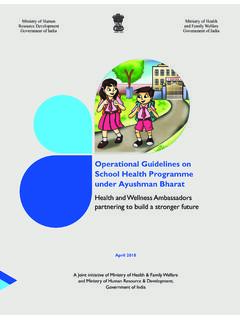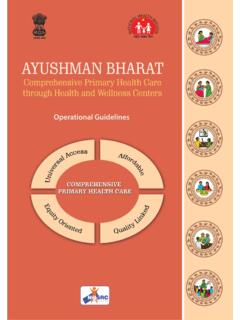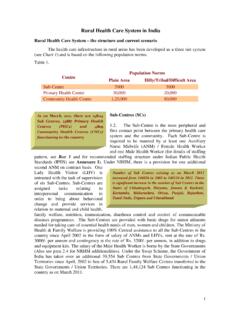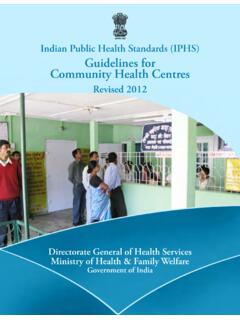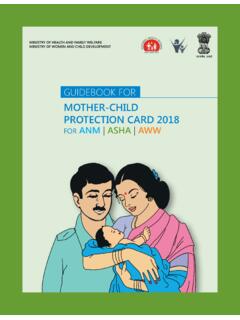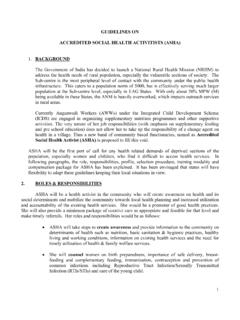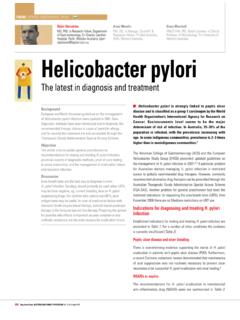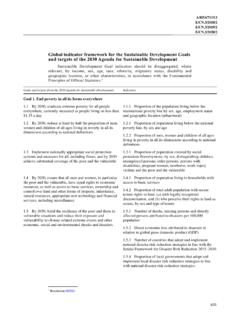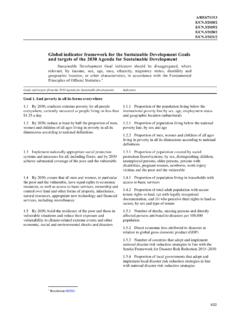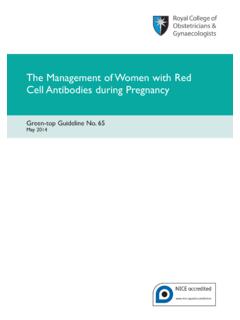Transcription of Guidelines for Control of Iron Deficiency Anaemia
1 Guidelines for Control ofIron Deficiency Anaemia Adolescent DivisionMinistry of Health and Family WelfareGovernment of India AcknowledgementsThe National Guidelines for Control of iron Deficiency Anaemia emerged out of wide based consultation. Preparation of the Guidelines would not have been possible without the valuable contributions of Maternal and Child Divisions of the Ministry of Health and Family Welfare and domain Secretary & Mission Director, NRHM Ms. Anuradha Gupta s encouragement was our inspiration and her strategic vision shaped the Secretary, RCH, Dr. Rakesh Kumar provided valuable insights and facilitated technical discussions which were critical for finalizing the of ContributorsMs. Anuradha Gupta Additional Secretary & Mission Director, NRHMDr.
2 Rakesh Kumar Joint Secretary, RCHDr. Virender Singh Salhotra Deputy Commissioner, Adolescent HealthMs. Anshu Mohan Programme Manager, Adolescent HealthDr. Sheetal Rahi Medical Officer, Adolescent HealthTechnical ExpertsProfessor Umesh Kapil, Department of Community Medicine, AIIMS Dr. HPS Sachdev, Paediatrician, Sita Ram Bhartia Institute of Science & Research Dr. PV Kotecha, Professor, Preventive and Social Medicine, Government Medical College, VadodaraProf. Suneeta Mittal, Gynaecologist & Obstetrician, Fortis HospitalDr. Prema Ramachandran, Director, Nutrition Foundation of IndiaDr. Abha Singh, Head, Deptt. of Gynaecology and Obstetrics, LHMC & SK HospitalDr. Vartika Saxena, Deptt. of Community Medicine, AIIMS, RishikeshSpecial Mention: Rajat Ray, Sr.
3 Advocacy & Communication Officer, UNFPA, was instrumental in the designing and printing of this document. Message Anaemia is a significant public health challenge in India. It has devastating effects on health, physical and mental productivity affecting quality of life, particularly among the vulnerable. Urgent action from all concerned is called for since Anaemia could translate into significant morbidities for affected individuals and consequent socio-economic losses for the country. Prevention and Control of Anaemia is one of the key strategies of the Health, Nutrition and Population Sector Programmes for reducing maternal, neonatal and childhood mortality and improving maternal, adolescent and childhood health status. I am confident that if the comprehensive sets of actions identified in National Guidelines for Control of iron Deficiency Anaemia are fully implemented; children, adolescents and women in India will have improved health outcomes and be able to achieve their fullest potential.
4 Implementation of this initiative in the right earnest would move us closer to reaching the Millennium Development Goals with regard to bringing down maternal and child mortality. The challenge before us now is to ensure the implementation of this initiative in its entirety and to further build upon it. Prevention and Control of Anaemia requires a coordinated response among multiple stakeholders and partners, and I request all to come forward to support interventions in line with the National Guidelines .(Ghulam Nabi Azad)(Ghulam Nabi Azad) P. K. PRADHANS ecretaryDepartment of Health & FWTel.: 23061863 Fax : 23061252e-mail : Rural Health MissionGOVERNMENT OF INDIAMINISTRY OF HEALTH & FAMILY WELFARENIRMAN BHAVAN, NEW DELHI - 110108- 110108 Message India is among the countries with high prevalence of Anaemia .
5 It is widely prevalent in all age groups, being particularly high among the most vulnerable; nearly 58 per cent in pregnant women, 50 per cent among non-pregnant non-lactating women, 56 per cent among adolescent girls, 30 per cent in adolescent boys and around 80 per cent in children under two years of age. Anaemia , thus poses a major threat to maternal and child survival, contributes to low birth weight, lowered resistance to infection, poor cognitive development and decreased work productivity. The magnitude of Anaemia together with the associated adverse health, development and economic consequences, highlights the need for intensified action to address this public health problem. Success in prevention and Control of Anaemia will contribute to reduction of maternal and child mortality and improve health outcomes for population as a whole.
6 In this context, National Guidelines for Control of iron Deficiency Anaemia has been developed to identify strategies and comprehensive actions needed across the life cycle to eliminate this serious obstacle to survival, health and development. The Guidelines have been designed to be handy and user friendly for service providers across levels and will be a useful tool in planning and implementing this initiative. I urge States and key stakeholders to prioritize implementation of iron + Initiative which will have long term impact on the health status of India s population.( Pradhan)Place: New Delhi 15th January, 2013( Pradhan) Anuradha Gupta, IASA dditional Secretary &Mission Director, NRHMT elefax : 23062157E-mail : of IndiaMinistry of Health & Family WelfareNirman Bhavan, New Delhi - 110108110108 Preface Anaemia is a major public health challenge in India.
7 Yet, a comprehensive plan of action to combat this problem has been missing. There are certain existing Guidelines for Control of iron Deficiency Anaemia with regard to children and pregnant women and lactating mothers. However, many critical age groups have been missing from this strategy. For instance, adolescents have received no attention so far. There have also been crevices by way of actual administration of IFA to children with several operational issues constraining the prescribed interventions. The National iron + Initiative is an attempt to look at iron Deficiency Anaemia comprehensively across all life stages including adolescents and women in reproductive age group who are not pregnant or lactating. The schedule of IFA supplementation has also been reviewed to make both administration and compliance much simpler.
8 For children, 6 months to 5 years, there is now a bi-weekly schedule of IFA supplementation with ASHA being responsible for administering the prescribed dosage under her direct supervision. For children of class I to class V in Government/Government aided schools, there is a much simpler weekly schedule of IFA supplementation, under the supervision of teachers. Similarly, adolescents from class VI to class XII receive weekly IFA supplementation in school itself. For women in reproductive age group who are neither pregnant nor lactating, ASHA shoulders the responsibility of providing IFA supplementation. Clearly, the National iron + Initiative builds on the gains of the NRHM, more particularly the strong work force of 8,80,000 ASHAs who have shown excellent potential to mobilise community for a large scale uptake of health services.
9 The fact that ASHAs are now undertaking home visits under the recently rolled out HBNC programme and are also doing home delivery of contraceptives to couples in the reproductive age group opens up several exciting opportunities for ASHAs to render additional services such as IFA supplementation. This initiative makes use of this wonderful opportunity in its bid to reach to all age groups Guidelines for Control of iron Deficiency Anaemia has four purposes:1. To bring to attention of program managers of health and health related activities the serious negative consequences of Anaemia for the health and physical, mental, and economic productivity of individuals and populations2. To layout IFA supplementation protocols across the life cycle (preventive strategy) 3.
10 To define a minimum standard treatment protocol for facility based management of mild, moderate and severe Anaemia segregated by levels of care (curative strategy)4. To broadly identify platforms of service delivery and indicate roles of service providersThese Guidelines have been developed taking cognizance of scientific evidence as well as considerable consultation with domain experts. It builds on past and continuing work on Anaemia prevention and Control in India and has been developed in the context of existing policies and strategies of the health, nutrition and population sector. It identifies comprehensive strategies and interventions for high risk groups, in particular infants and young children, adolescent girls, women in reproductive age, and pregnant and breastfeeding women, and for the population as a whole.
